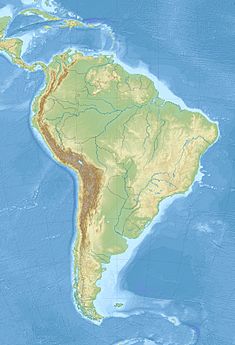Itaipu Dam facts for kids
Quick facts for kids Itaipu DamPresa Itaipu Barragem de Itaipu |
|
|---|---|
 |
|
|
Location of the Dam
|
|
| Official name | Central Hidroeléctrica Itaipú Binacional Usina Hidrelétrica Itaipu Binacional |
| Country | Brazil Paraguay |
| Location | Foz do Iguaçu Hernandarias |
| Coordinates | 25°24′29″S 54°35′20″W / 25.40806°S 54.58889°W |
| Status | Operational |
| Construction began | January 1971 |
| Opening date | 5 May 1984 |
| Construction cost | US$19.6 billion |
| Owner(s) | Itaipu Binational |
| Dam and spillways | |
| Type of dam | Combination gravity, buttress and embankment sections |
| Impounds | Paraná River |
| Height | 196 m (643 ft) |
| Length | 7,919 m (25,981 ft) |
| Dam volume | 12,300,000 m3 (430,000,000 cu ft) |
| Spillway capacity | 62,200 m3/s (2,200,000 cu ft/s) |
| Reservoir | |
| Creates | Itaipu Reservoir |
| Total capacity | 29 km3 (24,000,000 acre⋅ft) |
| Catchment area | 1,350,000 km2 (520,000 sq mi) |
| Surface area | 1,350 km2 (520 sq mi) |
| Maximum length | 170 km (110 mi) |
| Maximum width | 12 km (7.5 mi) |
| Power station | |
| Type | Conventional |
| Hydraulic head | 118 m (387 ft) |
| Turbines | 20 × 700 MW (940,000 hp) Francis-type |
| Installed capacity | 14 GW (19,000,000 hp) |
| Capacity factor | 73% |
| Annual generation | 89.5 TWh (322 PJ) (2015) |
| Website www.itaipu.gov.br www.itaipu.gov.py |
|
The Itaipu Dam is a hydroelectric dam on the Paraná River located on the border between Brazil and Paraguay. The construction of the dam was first contested by Argentina, but the negotiations and resolution of the dispute ended up setting the basis for Argentine-Brazilian integration later on.
The name "Itaipu" was taken from an isle that existed near the construction site. The Itaipu Dam's hydroelectric power plant produced the most energy of any in the world as of 2016, setting a new world record of 103,098,366 megawatt hours (MWh). Completed in 1984, it is a bi-national undertaking run by Brazil and Paraguay at the border between the two countries. In 2016, the plant employed 3038 workers.
Contents
History
Design studies began in February 1971. On April 26, 1973, Brazil and Paraguay signed the Itaipu Treaty, the legal instrument for the hydroelectric use of the Paraná River. On October 14, 1978, the Paraná River had its route changed, which allowed a section of the riverbed to dry so the dam could be built there.
The reservoir began its formation on October 13, 1982, when the dam works were completed and the side canal's gates were closed. Throughout this period, heavy rains and flooding accelerated the filling of the reservoir as the water rose 100 meters (330 feet) and reached the gates of the spillway at 10:00 on October 27. On May 5, 1984, the first generation unit started running in Itaipu. The first 18 units were installed at the rate of two to three a year; the last two of these started running in the year 1991.
Construction
- The course of the seventh biggest river in the world was shifted, as were 50 million tons of earth and rock.
- The amount of concrete used to build the Itaipu Power Plant would be enough to build 210 football stadiums the size of the Estádio do Maracanã.
- The iron and steel used would allow for the construction of 380 Eiffel Towers.
- The volume of excavation of earth and rock in Itaipu is 8.5 times greater than that of the Channel Tunnel and the volume of concrete is 15 times greater.
- Around forty thousand people worked in the construction.
- Itaipu is one of the most expensive objects ever built.
Generating station and dam
- The total length of the dam is 7,235 metres (23,737 ft). The crest elevation is 225 metres (738 ft). Itaipu is actually four dams joined together – from the far left, an earth fill dam, a rock fill dam, a concrete buttress main dam, and a concrete wing dam to the right.
- The spillway has a length of 483 metres (1,585 ft).
- The maximum flow of Itaipu's fourteen segmented spillways is 62.2 thousand cubic metres per second (2.20×106 cu ft/s), into three skislope formed canals. It is equivalent to 40 times the average flow of the nearby natural Iguaçu Falls.
- The flow of two generators (700 cubic metres per second (25,000 cu ft/s) each) is roughly equivalent to the average flow of the Iguaçu Falls (1,500 cubic metres per second (53,000 cu ft/s)).
- The dam is 196 metres (643 ft) high, equivalent to a 65-story building.
- Though it is the seventh largest reservoir in size in Brazil, the Itaipu's reservoir has the best relation between electricity production and flooded area. For the 14,000 MW installed power, 1,350 square kilometres (520 sq mi) were flooded. The reservoirs for the hydroelectric power plants of Sobradinho Dam, Tucuruí Dam, Porto Primavera Dam, Balbina Dam, Serra da Mesa Dam and Furnas Dam are all larger than the one for Itaipu, but have a smaller installed generating capacity. The one with the next largest hydroelectric production, Tucuruí, has an installed capacity of 8,000 MW, while flooding 2,430 km2 (938 sq mi) of land.
- Electricity is 55% cheaper when made by the Itaipu Dam than the other types of power plants in the area.
Wonder of the Modern World
In 1994, the American Society of Civil Engineers elected the Itaipu Dam as one of the seven modern Wonders of the World. In 1995, the American magazine Popular Mechanics published the results.
Images for kids
See also
 In Spanish: Represa de Itaipú para niños
In Spanish: Represa de Itaipú para niños






